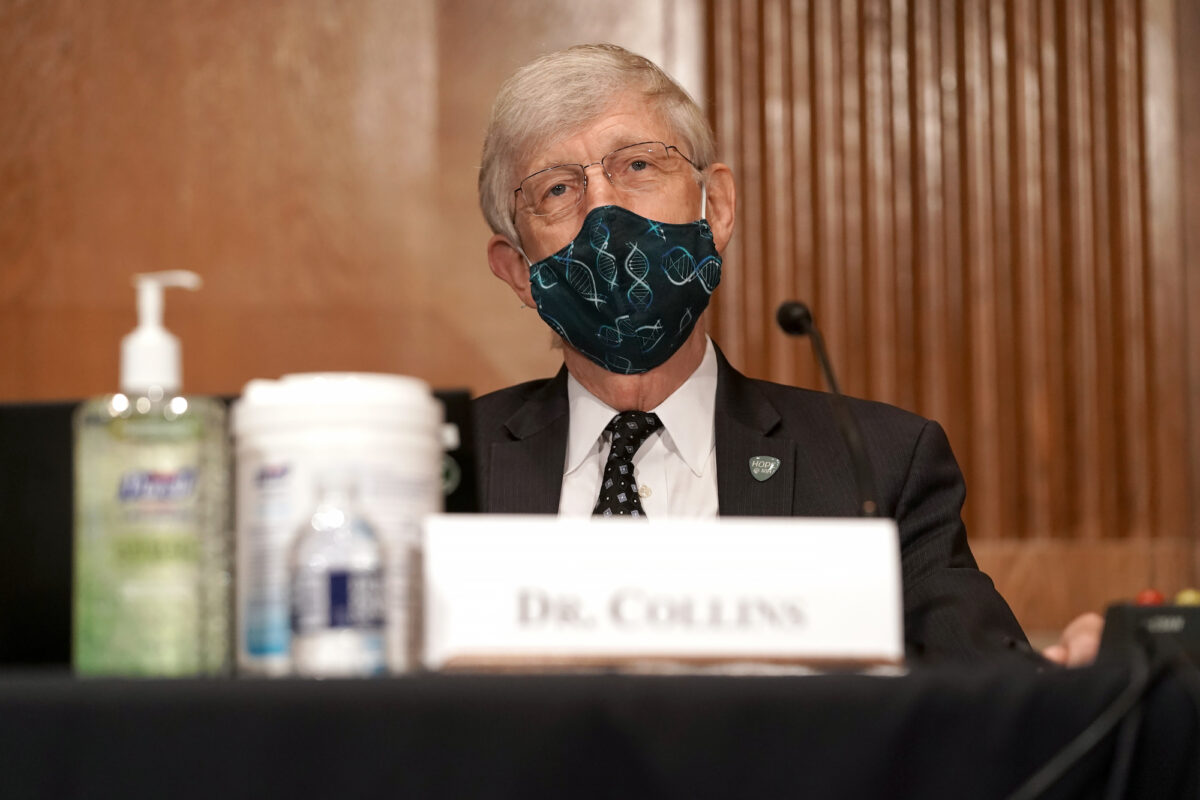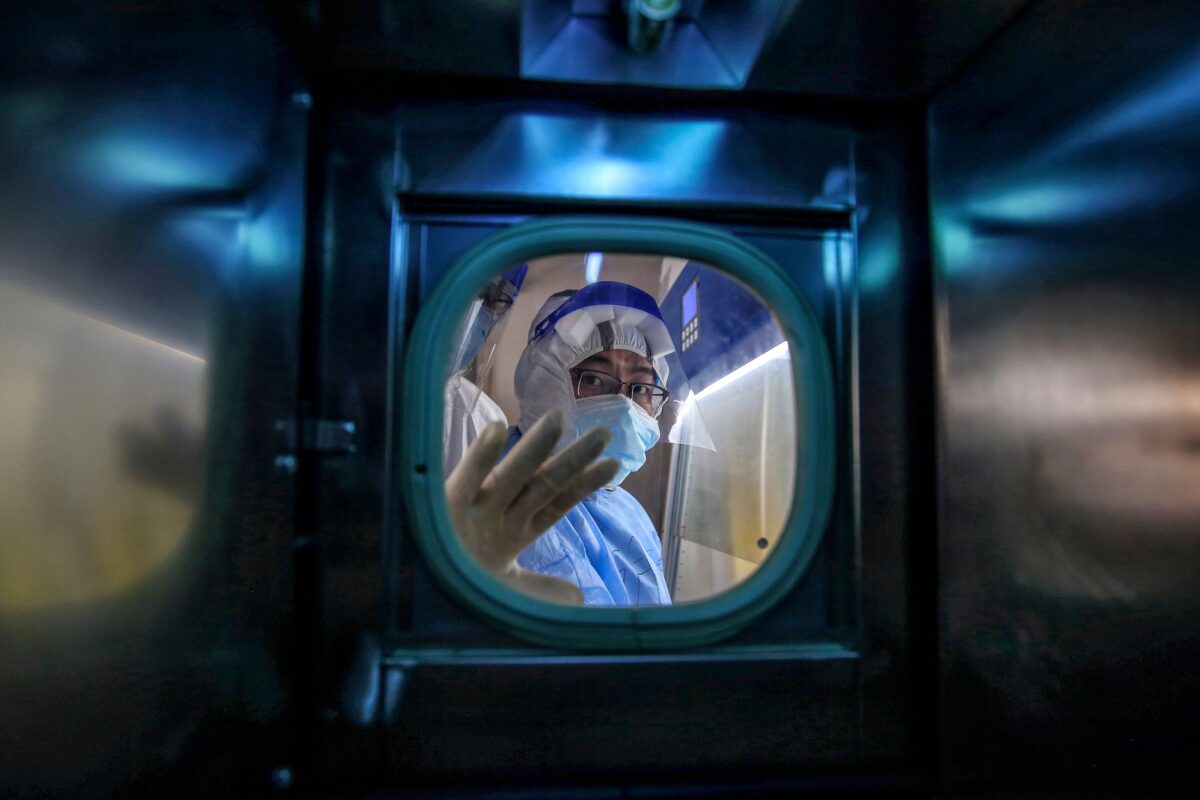Commentary
After nearly two years of denials, Dr. Anthony Fauci’s parent organization, the National Institutes of Health (NIH), has finally conceded that it had funded gain-of-function experiments at the Wuhan Institute of Virology.
As these admissions were made, NIH officials told Congress that the viruses being experimented on were too genetically distant to have possibly caused COVID-19.
But the NIH failed to tell Congress that Peter Daszak’s EcoHealth Alliance, the organization through whom Fauci was funding the Wuhan Institute, has kept a large number of unknown viruses in its possession. And only those with access to these viruses know what was done with them or exactly how genetically close to COVID-19 they actually are. Additionally, the Institute deleted its entire database of over 22,000 previously unreported virus samples on Sept. 12, 2019.
At exactly the same time that the NIH was making the gain-of-function admission, the agency quietly edited its website to redefine what constituted gain-of-function experiments. In doing so, the NIH narrowed its definition to focus only on known and established human transmission, instead of any potential dangers to humans.
The belated gain-of-function disclosure was made by Lawrence Tabak, the deputy principal director of the NIH, who noted in a letter to Congress, that, despite its previous denials, the NIH had, in fact, funded gain-of-function experiments at the Wuhan facility.
Tabak’s letter, written in response to congressional inquiries, corrected previous assertions by NIH Director Dr. Francis Collins and National Institute of Allergy and Infectious Diseases Director Fauci that the NIH hadn’t funded gain-of-function research in Wuhan. Tabak also acknowledged that EcoHealth, the body through whom Fauci funded the Wuhan lab, had violated the terms and conditions of its NIH grant.
But Tabak’s assertion that the NIH was unaware of gain-of-function work being conducted by EcoHealth was contested in a statement issued by EcoHealth in response, which noted that “[t]hese data were reported as soon as we were made aware, in our year four report in April 2018.”
2018 EcoHealth Report Details Gain-of-Function Work in Wuhan
EcoHealth failed to provide the NIH with its contractually obligated 2019 fifth-year report until this month, although EcoHealth did share data with the NIH in 2018 and in previous years as part of earlier annual progress reports. Those reports were required as a condition of the five-year grant that Fauci’s NIAID had awarded to EcoHealth in 2014.
Notably, EcoHealth’s 2018 report should have immediately alerted the NIH that agency money was being used to create coronaviruses that were far more pathogenic than the original viruses.

EcoHealth’s April 2018 report specified that it, in collaboration with the Wuhan facility, applied reverse genetic methods to construct artificial viruses. These newly created viruses contained novel spike proteins. As Daszak would later explain in a Dec. 9, 2019, interview, the “spike protein drives a lot of what happens with the coronavirus.”
The resulting genetically modified viruses exhibited particularly high pathogenicity in humanized mice, with a viral load that was enhanced by a factor of 10,000. The construction of at least three such viruses was detailed in EcoHealth’s April 2018 report.
The report also stated that EcoHealth and the Wuhan lab were moving forward with similar work to be done on a different type of virus, the far more lethal MERS virus.
A second report was submitted by EcoHealth to the NIH in November 2018. That report, which took the form of a proposal for a second five-year grant, again described the same gain-of-function work laid out in the April 2018 report.
The 2018 disclosures by EcoHealth highlight two problems. First, EcoHealth had already violated the terms of its grant, which stated that if any artificial viruses showed evidence of enhanced virus growth by a factor of 10, NIH must be notified and all experiments with these viruses must stop immediately. But EcoHealth failed to follow the grant requirements and only notified NIH of the viral growth through a routine disclosure in an annual progress report.

This violation by EcoHealth should have prompted immediate action on the part of NIH.
Secondly, the fact that EcoHealth made the NIH aware of the results of its gain-of-function experiments in 2018, placed an inherent oversight requirement on NIH to closely monitor EcoHealth’s experiments going forward. Instead, the NIH allowed Daszak’s team to continue their work without any monitoring for the next several years.
Missing EcoHealth Report Describes Lethal Virus Work
The lack of EcoHealth’s submission of a fifth-year progress report was only recently discovered, after The Intercept sued the NIH for documents relating to EcoHealth. If not for the alarms raised by The Intercept, it’s likely that EcoHealth’s fifth-year progress report would remain unsubmitted.
That fifth-year report described how EcoHealth and the Wuhan lab engaged in additional gain-of-function experiments by constructing clones of the deadly MERS virus—a virus with a case-fatality rate of 35 percent. The report also detailed how researchers at the Wuhan facility replaced the virus’s receptor-binding domain, which forms part of the spike protein—which determines the virus’s pathogenicity.
The gain-of-function work that EcoHealth described in the delayed fifth-year progress report appears to directly contradict a September 2021 statement made before the fifth report was finally released, when an EcoHealth spokesperson claimed that “[t]]he MERS work proposed in the grant is suggested as an alternative and was not undertaken.”
Tabak’s letter to Congress also stated that NIH had determined that Daszak’s experiments didn’t require strict oversight from NIH because the bat coronaviruses originally cited in Daszak’s work hadn’t been shown to infect humans.

But one of the viruses tested by Daszak, WIV1-SHC014, a lab-created virus that had already been mentioned in the 2018 report, exhibited high lethality on humanized mice. According to Daszak’s belatedly submitted fifth-year progress report, 75 percent of the humanized mice that were infected with the virus died.
Humanized mice are mice that have been adapted to carry functioning human genes, cells, and tissue. They effectively act as experimental stand-ins for humans, particularly when testing whether a new virus is capable of infection and transmission in humans.
NIH Changes Gain-of-Function Definition
The NIH suddenly and quietly removed its long-standing definition of gain-of-function experiments from its website at around the same time that Tabak wrote his letter, replacing it with a new section on enhanced potential pandemic pathogens (ePPP) research.
The NIH’s previous, long-standing definition focused on potential danger to humans. It stated that any NIH-funded gain-of-function research that was “anticipated to enhance the transmissibility and/or virulence of potential pandemic pathogens, which are likely to make them more dangerous to humans ” could only be conducted subject to “stringent oversight and appropriate biosafety and biosecurity controls.”
That definition was materially modified, narrowing the focus to humans to known and established human transmission—specifically “the enhancement of a pathogen’s transmissibility and/or virulence in humans”—from potential dangers.
The NIH’s new gain-of-function wording was remarkably similar to a statement from Fauci’s spokesperson, who said that EcoHealth’s research didn’t fall under strict NIH oversight since the funded experiments “were not reasonably expected to increase transmissibility or virulence in humans.”
This new definition was echoed by Tabak in his recent letter to Congress, when he wrote that Daszak’s work “did not fit the definition of research involving enhanced pathogens of pandemic potential or ePPP because these bat coronaviruses had not been shown to infect humans.”
Professor Richard Ebright, a biologist at Rutgers University, wrote on Twitter: “In essence, they are claiming that, because the NIH did not fund infection studies with lab-generated viruses and human subjects—Uyghur detainees? Falun Gong dissidents?—the NIH did not fund gain of function research.”
The new gain-of-function terminology may have originated with NIH Director Collins, who appears to have foreshadowed the definitional shift in a May 2021 statement when he claimed that NIH didn’t fund research on coronaviruses that “increased their transmissibility or lethality for humans.”
At the time of Collins’ statement, questions were beginning to be raised for the first time in the corporate media about COVID-19’s origins and NIH’s funding of gain-of-function experiments at the Wuhan Institute of Virology. Collins himself had strongly denied that gain-of-function experiments had been funded at the lab, calling the reports misinformation.
NIH Claims EcoHealth Work ‘Distant’ From COVID but Ignores Hidden Viruses
On the same day that Tabak’s letter was sent to Congress, the NIH published a separate statement claiming that none of the work it had funded in Wuhan through EcoHealth Alliance could have led to the creation of COVID-19.
The NIH stated that “it is evident that the viruses studied under the EcoHealth Alliance grant are very far distant from SARS-CoV-2.”

But the NIH failed to disclose that it simply isn’t possible to know what viruses were being studied by EcoHealth and the lab in Wuhan. The Institute deleted its database of viral samples in September 2019; the database remains missing. In addition, Peter Daszak, the Institute’s longtime collaborator, has admitted to holding a large number of undisclosed viruses.
The NIH also failed to acknowledge the existence of a blueprint for the creation of a COVID-19-like virus. In 2018, EcoHealth submitted a proposal to the Pentagon’s Defense Advanced Research Projects Agency (DARPA) program that detailed the organization’s plan to create entirely new coronaviruses through the synthetic combination of preexisting virus backbones. The proposal described how those viruses were going to be made more virulent in humans by the insertion of a furin cleavage site, a feature that distinguishes COVID-19 from all other SARS-related coronaviruses.
The furin cleavage site is the key to COVID-19’s pathogenicity in humans. Notably, the director of the Wuhan Institute of Virology, Shi Zhengli, left out any mention of COVID-19’s furin cleavage site when she first described the COVID-19 virus in a detailed Feb. 2020 article in the science journal Nature.
Despite its previous denials, the NIH knew that EcoHealth and the Wuhan Institute of Virology had conducted gain-of-function experiments that resulted in highly pathogenic viruses, and failed to hold EcoHealth accountable for requirements that the NIH itself had imposed.
Perhaps most importantly, the NIH knew that these experiments were being conducted on the soil of an adversary of the United States—communist China.
